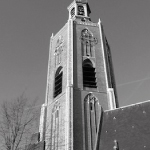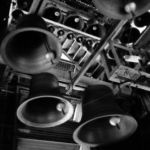English
Beginnings
Bells have been used for centuries by ecclesiastical and secular governing bodies for all kinds of signals to the inhabitants of cities and villages. Clockworks provided with a bel land a clock-face indicated the time of day.
In the Low Countries the custom arose to have time-indicating bell peals preceded by a brief melody on a number of small bells. This series of small bells expanded over time. This led to the carillon, being played not only automatically but also by means of a baton keyboard, played at specific times by a professional musician. From the fifteenth century onwards, throughout the centuries, The Hague also took part in this devellopment, influenced by the counts' court.
Present situation in The Hague
Nowadays The Hague holds an almost unique position within the carillon culture of the Low Countries; during the whole year seven concerts are given in the course of each week, divided among three towers, each with an instrument with a character of its own.
The Grote Kerk carillon, in the center of The Hague, started in the fifteenth century with a modest range. Nowadays the instrument has a range of 51 bells. Every day it marks the time each quarter of an hour from 8.15 am untill 21.00 pm with a short melody. Concerts are given by the city carillonneur - Gijsbert Kok - on Monday, Wednesday and vryday 12-13 pm. The best place to listen is in the Nutstuin [the Nutsgarden]. The entrance: Jan Hendrikstraat, near the Grote Kerk.
The Scheveningen carillon is - with 37 bells - newly installed in 1975 in the Oude Kerk tower [tower of the Old Church] in the Keizerstraat. City carillonneur Gijsbert Kok plays the bells mostly every wednesday 14.30-15.30 pm and Saturday 11-12 am.
The third carillon in The Hague - the Peace Carillon - was installed in 1994 in the main tower of The Peace Palace, the international Court of Justice of the United Nations. Behind the reverb plates bell foundry Royal Eijsbouts (Asten) installed the bells in a loft that had been made for it. Its baton keyboard is in a higher loft above the bells. This carillon - 47 bells - is strictly a concert instrument, as it does not function as an indicator of the time of day. The weekly concerts are given by several carillonneurs on Tuesday and Thursday from 13.00 - 13.45 pm.
An international network of Peace Bells
Around the world there are more bells or carillons dedicated to the theme of Peace or to the remembrance of War. Examples may be found in Australia (the Australian War Memorial Carillon, Sidney), Austria (Peace Carillon, Innsbruck and Peace Bell, Mösern/Tyrol), Belgium (The Leuven University carillon), Canada (Parliament of Canada / The Peace Tower in Ottawa), Germany (the Peace Bells in Altenburg/Saxony), Italy (the Peace Bell of Rovereto/Trento), New Zealand (National War Memorial, Wellington), and U.S.A. (several places, omong others: Arlington).
Information
See for more information in general: www.carillon.org (World Carillon Federation).
New music book (#6) available now
In the context of the commemoration of the Reformation (1517 - 2017), city- carilloneur Gijsbert Kok arranged a number of protestant compositions for the carillon. The works are based on chorales by Martin Luther and Genevan psalmtunes. They originate from the 16th - 18th century and are by composers like Van Eyck, Scheidt, Buxtehude and Bach. The composer Johann Th. Lemckert from The Hague has been requested to write a Triptyque, based on three chorals by Luther.
You can obtain a free hard copy of the book, while stock lasts, by sending your name and address to info@gijsbertkok.nl



